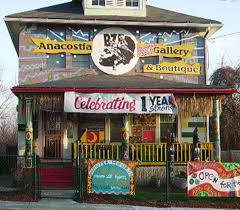[contextly_auto_sidebar id=”U9ZKZeEOtHhedFzv5Is4iOgEuSU4DzmA”]
The Go-Go Symphony — which plays some of the most exciting music in Washington, DC, a perfect fusion of classical music and funk — is in line for a great honor, and a great opportunity. I’ve blogged about their first triumphant performance with a full symphonic ensemble, and their founder, Liza Figueroa Kravinsky, has done guest posts about how she developed the group. (She talks here, for instance, about the group’s big breakthrough into the heart of the go-go world, go-go being DC’s iconic funk style, dating back to the ‘70s, and still going strong.)
 The honor and opportunity for them — after opening at a club for Trouble Funk, the legendary DC go-go band, and playing three shows (a fourth is coming in March) with the Capital City Symphony at the Atlas Performing Arts Center — is that they were picked by the DC government to represent the city at South by Southwest. The idea is that DC and the surrounding area, already a tech hive, might be very attractive to the tech-oriented people who come to SXSW. And since SXSW features music…
The honor and opportunity for them — after opening at a club for Trouble Funk, the legendary DC go-go band, and playing three shows (a fourth is coming in March) with the Capital City Symphony at the Atlas Performing Arts Center — is that they were picked by the DC government to represent the city at South by Southwest. The idea is that DC and the surrounding area, already a tech hive, might be very attractive to the tech-oriented people who come to SXSW. And since SXSW features music…
A little hitch, though. The city — maybe this wasn’t absolutely its best moment — didn’t put funding behind its decision to send the group to SXSW, which happens in Austin, in March. So Liza has to raise $30,000 by (gasp) the end of the month.
Why this rules
And why is this a great thing?
Well, the Go-Go Symphony, as I said, is the most perfect fusion I’ve ever heard of classical music and — well, any pop genre. I heard them for the second time last June at the Atlas, and things had come together mightily since last year. (Repeating the link to my post about their first Atlas show.)The sound mix was solid, and the music, classically-styled for the orchestra, and rocked out by go-go drummers, was both hot and skilfully done.
One feature of go-go is that the drums (typically four congas) play all through a go-go show, between songs as well as duirng shows. So the party never stops. Let that happen with a full symphony orchestra, and you have something very new. The orchestra does what orchestras do, the drummers (along with dancers and rappers) do what go-go does, and everything fuses into a single entity.
Two things to note…
…at that June Atlas show.
First, a shout-out to Anacostia, an old-line African-American neighborhood in DC, in the last movement of a piece called the Green Line Symphony, composed by Peter Van Siclen, and premiered at the June performance. Its four movements are named for stops on DC’s Green Line, part of its Metro system, and the music celebrates the neighborhoods they’re in: Chinatown, Columbia Heights, U Street (with its clubs and Ethiopian restaurants, and of course Ben’s Chili Bowl, one of the legendary DC eating places, run by AFrican-Americans).
 And Anacostia. We don’t hear much about Anacostia at DC classical concerts.
And Anacostia. We don’t hear much about Anacostia at DC classical concerts.
Then this. When the show was over, Ashley Jenkins, the engaging rapper who starred in the performance, led the orchestra in taking some bows. But not in classical style. “Woodwinds!” she cried to the audience. “Give them some love!” Not what we’d hear at the Kennedy Center. But standard in the music heard more or less everywhere else, so why not bring it to classical? Check your calendars. 2015, everyone. Orchestras could all be taking bows like that.
More vignettes
A Washington Post review (not by my wife): “It brought the sold-out house to its feet, cheering.”
Plus this: The Go-Go Symphony was picked to represent local DC culture at the annual Congressional Correspondents Dinner last June. Or, in other words, going far away from go-go clubs and the arts, to penetrate the heart of official Washington.
You can watch a video of part of one of their Atlas performances. It won’t show you their classical side, won’t let you hear that the Green Line Symphony was a respectable piece of classical work. But you’ll see what a party these performances are. (And you do see conductor John Devlin leadfing what’s clearly music with something going on. You just can’t hear what that something is.)
And, coming in March: Joining the Symphony, to rule its drummers, is Ju-Ju House, the leading go-go drummer in DC, and an accomplished pro in other pop genres. Which adds to their pop clout, and gives them an even stronger beat.
So help them get funded!
Of course I don’t expect blog readers to float any large part of what’s needed. But anyone who can help ideas or leads can contact Liza. And if you’d like to donate, you can go here.
As I always do when I talk about the Go-Go Symphony, I should note that I was a consultant to Liza when she started the group, and introduced her to John Devlin, Associate Conductor of the Capital City Symphony. But I can’t take credit for anything past some very early steps. Liza did all the rest on her own.
***
Someone deep into classical music may ask why DC wants to advertise itself with anything like go-go. Doesn’t culture make a town attractive, and don’t corporations want an orchestra and opera company, and maybe a ballet, in any town they move to, in order to attract employees?
Not any more. And it’s surprising, even, that anyone would still think this. Is classical music an attraction for the smart, enterprising younger people corporations want to hire? Plainly not. The classical music audience, old story, is older. Not full of people looking for exciting new jobs. Or, to put it the other way round, our concert halls plainly aren’t full of young entrepreneurs, graphic designers, tech wizards, and startup CEOs.
But people who looked like they might be in those groups were at the Go-Go Symphony. And at the NSO’s recent show in a huge dance club, which I blogged about).
For more on this, read an excerpt from a well-known book by Richard Florida, The Rise of the Creative Class, which I assign in my Juilliard course on the future of classical music.
The “creative class” is Florida’s name for the people I’m talking about here — smart, enterprising, creative younger types, who (as Florida shows) bring new life to cities. The part of the book I assign is about the creative class’s nightlife. And it starts with Florida rejecting, flat out, the idea that a symphony, an opera, or a ballet is what creative younger people want.
Instead they want things that are diverse, surprising, happening on or near the street, things that are original, authentic, and contemporary. Which in music means a local scene with a distinctly local flavor. Hello, go-go! Florida includes all kinds of things that people might go to when they’re out at night, from storefront galleries to small-theater productions of 18th century comedies. But the Go-Go Symphony would seem to fit his observations quite exactly. As — sadly, for many of us — almost nothing in old-line classical music does.
